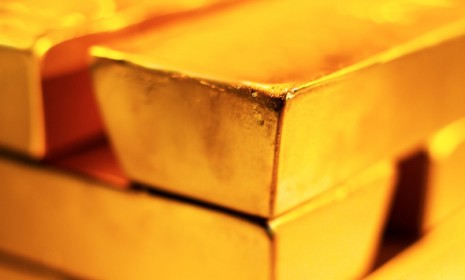The bacteria that turns toxic chemicals into pure gold
Introducing the microbe with the Midas touch

Researchers at Michigan State University have discovered bacteria with the remarkable ability to turn toxic chemical compounds into 24-karat gold. The breakthrough, detailed in a combination art and biotechnology exhibition called "The Great Work of the Metal Lover," is described by researcher Adam Brown as modern day "neo-alchemy." Here's what you should know:
What is this bacteria, exactly?
The microbe, Cupriavidus metallidurans, possesses the unique ability to survive in extremely toxic environments. A few years ago, researchers discovered the bacteria growing on gold nuggets at two separate sites hundreds of miles apart in Australia. That got scientists thinking: Does this bacteria just happen to live in the vicinity of gold, or do they actually create gold?
The Week
Escape your echo chamber. Get the facts behind the news, plus analysis from multiple perspectives.

Sign up for The Week's Free Newsletters
From our morning news briefing to a weekly Good News Newsletter, get the best of The Week delivered directly to your inbox.
From our morning news briefing to a weekly Good News Newsletter, get the best of The Week delivered directly to your inbox.
Well... do these bacteria actually turn chemicals into gold?
Yes. Kazem Kashefi, assistant professor of microbiology and molecular genetics, and Adam Brown, associate professor of electronic art and intermedia, discovered that C. metallidurans could grow and prosper if placed on gold chloride, an otherwise worthless yet toxic chemical. Using a portable laboratory made out of the bacteria, a glass bioreactor, and 24-karate gold-plated hardware, the team continually fed the bacterium "unprecedented amounts of gold chloride," says R&D Mag. Not only were the bacteria extraordinarily resistant to gold chloride's toxicity, but in about a week, they converted the toxic chemical into 99.9 percent pure gold. The details are a bit complicated, says Jesus Diaz at Gizmodo, but basically, "Cupriavidus metallidurans can eat toxins and poop out gold nuggets."
What does this mean for gold production?
Although the Michigan State University experiment was successful, it could be "cost prohibitive to reproduce [this] experiment on a larger scale," says R&D Mag. So don't expect to grow your own gold at home anytime soon.
A free daily email with the biggest news stories of the day – and the best features from TheWeek.com
Sources: Biofuel Digest, Gizmodo, R&D Mag, Science Daily
-
 Film reviews: ‘Marty Supreme’ and ‘Is This Thing On?’
Film reviews: ‘Marty Supreme’ and ‘Is This Thing On?’Feature A born grifter chases his table tennis dreams and a dad turns to stand-up to fight off heartbreak
-
 Political cartoons for December 14
Political cartoons for December 14Cartoons Sunday's political cartoons include a new White House flag, Venezuela negotiations, and more
-
 Heavenly spectacle in the wilds of Canada
Heavenly spectacle in the wilds of CanadaThe Week Recommends ‘Mind-bending’ outpost for spotting animals – and the northern lights